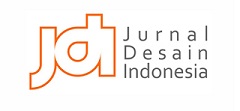KAJIAN PERGESERAN BENTUK DAN MAKNA BUSANA ADAT MADYA PRIA BALI
Abstract
As a diverse country, Indonesia has various kinds of traditional clothing in each region. Each of this distinct traditional clothing represents the culture, tradition and craft within the area. Like the Balinese traditional clothing that is composed with shapes and meaning in accordance of their culture, tradition, and craft. Which the usage of this traditional fabric becomes one of a fundamental characteristic of Balinese traditional clothing. Balinese traditional clothing consists of three separate groups, that is Nista, Madya and Utama which each serves different purposes. The Madya traditional clothing often aimed at the man to go to the temple is currently being misused and shift their meaning and form which become a main issue of traditional clothing usage to the temple. This inappropriate usage of traditional clothing to the temple is based on several factors, one of them is the lack of appropriate knowledge about form and meaning of Madya traditional clothing, especially when it used to pray at the temple. By making direct observation, which based on several literatures, the usage of traditional clothing is divided into three important parts called the Tri Angga concept. Each of these parts has a deep meaning related to human responsibility to carry out the teaching of truths. The upper, middle and lower parts of the human body are related to each other to interpret the meaning of the traditional clothing that being worn.
Keywords
Full Text:
PDF (Bahasa Indonesia)References
Aprilia, A., & Agung, A. A. (2020). Tata Rias Pengantin Bali. Jakarta: Gramedia Pustaka Utama.
Astuti, A. D. (2020). Kajian Elemen Estetik Pada Ruang Tunggu Gedung Doktoral Universitas. NARADA Jurnal Desain dan Seni, Vol. 7(3), 425-437.
Berman, M. (1998). “The Experience of Modernity” dalam J. Thackara (ed.), Design After Modernism. London: Thames and Huston.
Dewi, I. A., & Satria, I. K. (2020). Konsep Tri Angga Dalam Belajar Teknik Tari Bali. Widyanatya, Vol. 2(1), 39-46.
Fathoni, A. (2006). Metodologi Penelitian dan Teknik Penyusunan Skripsi. Jakarta: Rineka Cipta.
Koentjaraningrat. (1985). Kebudayaan, Mentalitas dan Pembangunan: bunga rampai. Jakarta: PT Gramedia Pustaka Utama.
Sastra, A. I. (2019). Estetika Pola Tiga: Konsep Musikal Talempong Renjeang Dan Dinamika Keagamaan Di Minangkabau. Dewa Ruci: Jurnal Pengkajian dan Penciptaan Seni, Vol.14(1), 34-44.
Sumardjo, J., & Caturwati, E. (2010). Estetika Pradoks. Bandung: STSI.
Suyatra, I. P. (2017, Desember 24). Pakaian adat Simbolik Dharma, Ini Penjelasannya. Retrieved from Jawa Pos Group Bali Express: https://baliexpress.jawapos.com/balinese/24/12/2017/pakaian-adat-ungkap-simbolik-dharma-ini-penjelasannya/
Wahono. (2004). Gaya Ragam Hias Batik: (Tinjauan Makna Dan Simbol). Semarang: UNNES Pres.
Zed, M. (2008). Metode Penelitian Kepustakaan. Jakarta: Yayasan Obor Indonesia.
DOI: http://dx.doi.org/10.22441/narada.2023.v10.i1.001
Refbacks
- There are currently no refbacks.
Fakultas Desain dan Seni Kreatif
Universitas Mercu Buana
Gedung E Lantai 4
Jl. Raya Meruya Selatan no.1, Kembangan, Jakarta 11650
Tlp./Fax: +62215871335
Journal International Standard Serial Number (ISSN) Registration:
The Journal is indexed by:
Tools for Citations & Plagiarism Detection:

Ciptaan disebarluaskan di bawah Lisensi Creative Commons Atribusi-NonKomersial 4.0 Internasional
 NARADA: Jurnal Desain dan Seni
NARADA: Jurnal Desain dan Seni

























